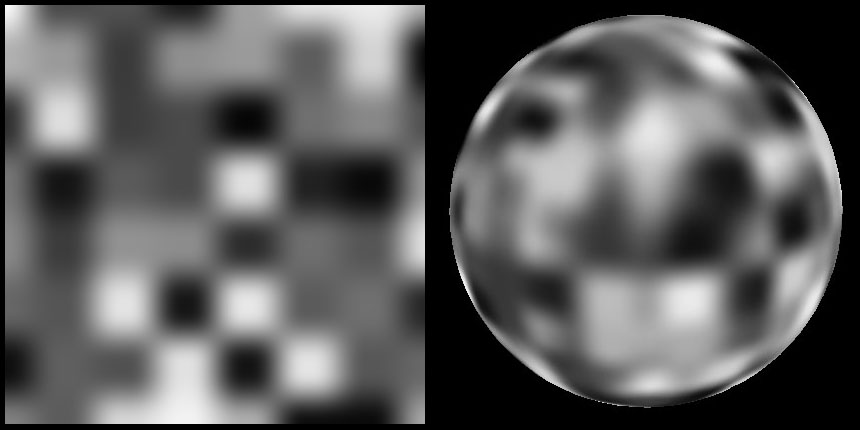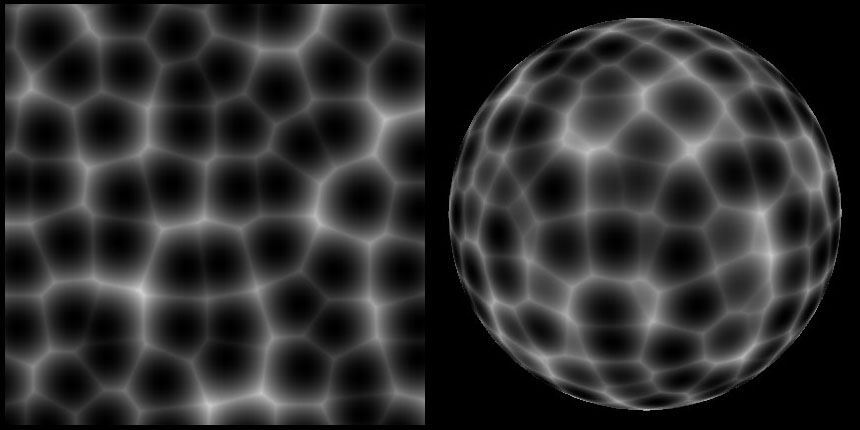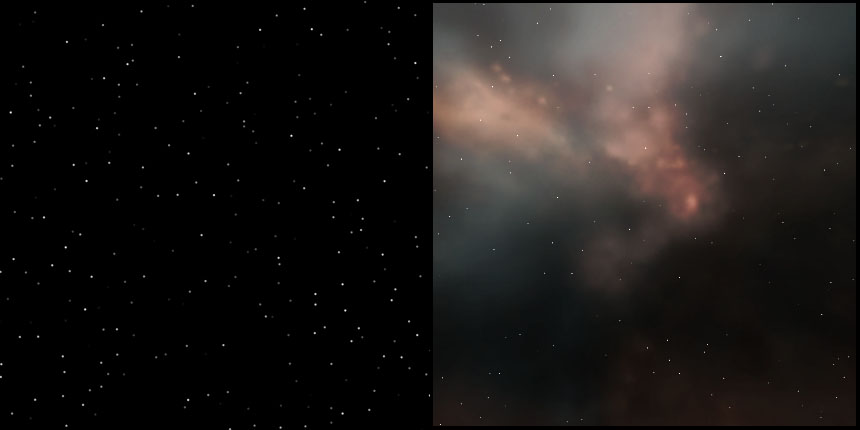GPU Noise Library¶
Codea includes the GPU noise library written by Brian Sharpe (http://briansharpe.wordpress.com), all credit goes to the original author
The library can be inclued via #include <codea/noise/noise.glsl> within any GLSL source
An example using this library can be found here
//
// Code repository for GPU noise development blog
// http://briansharpe.wordpress.com
// https://github.com/BrianSharpe
//
// I'm not one for copyrights. Use the code however you wish.
// All I ask is that credit be given back to the blog or myself when appropriate.
// And also to let me know if you come up with any changes, improvements, thoughts or interesting uses for this stuff. :)
// Thanks!
//
// Brian Sharpe
// brisharpe CIRCLE_A yahoo DOT com
// http://briansharpe.wordpress.com
// https://github.com/BrianSharpe
//
Value Noises¶

// Value Noise 2D
// Return value range of 0.0->1.0
// http://briansharpe.files.wordpress.com/2011/11/valuesample1.jpg
//
float Value2D( vec2 P )
// Value Noise 3D
// Return value range of 0.0->1.0
// http://briansharpe.files.wordpress.com/2011/11/valuesample1.jpg
//
float Value3D( vec3 P )
// Value Noise 4D
// Return value range of 0.0->1.0
//
float Value4D( vec4 P )

// Perlin Noise 2D ( gradient noise )
// Return value range of -1.0->1.0
// http://briansharpe.files.wordpress.com/2011/11/perlinsample.jpg
//
float Perlin2D( vec2 P )
// Perlin Noise 3D ( gradient noise )
// Return value range of -1.0->1.0
// http://briansharpe.files.wordpress.com/2011/11/perlinsample.jpg
//
float Perlin3D( vec3 P )
// Perlin Noise 4D ( gradient noise )
// Return value range of -1.0->1.0
//
float Perlin4D( vec4 P )

// ValuePerlin Noise 2D ( value gradient noise )
// A uniform blend between value and perlin noise
// Return value range of -1.0->1.0
// http://briansharpe.files.wordpress.com/2011/11/valueperlinsample.jpg
//
float ValuePerlin2D( vec2 P, float blend_val )
// ValuePerlin Noise 3D ( value gradient noise )
// A uniform blend between value and perlin noise
// Return value range of -1.0->1.0
// http://briansharpe.files.wordpress.com/2011/11/valueperlinsample.jpg
//
float ValuePerlin3D( vec3 P, float blend_val )

// Cubist Noise 2D
// http://briansharpe.files.wordpress.com/2011/12/cubistsample.jpg
//
// Generates a noise which resembles a cubist-style painting pattern. Final Range 0.0->1.0
// NOTE: contains discontinuities. best used only for texturing.
// NOTE: Any serious game implementation should hard-code these parameter values for efficiency.
//
float Cubist2D( vec2 P, vec2 range_clamp ) // range_clamp.x = low, range_clamp.y = 1.0/(high-low). suggest value low=-2.0 high=1.0
// Cubist Noise 3D
// http://briansharpe.files.wordpress.com/2011/12/cubistsample.jpg
//
// Generates a noise which resembles a cubist-style painting pattern. Final Range 0.0->1.0
// NOTE: contains discontinuities. best used only for texturing.
// NOTE: Any serious game implementation should hard-code these parameter values for efficiency.
//
float Cubist3D( vec3 P, vec2 range_clamp ) // range_clamp.x = low, range_clamp.y = 1.0/(high-low). suggest value low=-2.0 high=1.0
Cellular Noises¶

// Cellular Noise 2D
// Based off Stefan Gustavson's work at http://www.itn.liu.se/~stegu/GLSL-cellular
// http://briansharpe.files.wordpress.com/2011/12/cellularsample.jpg
//
// Speed up by using 2x2 search window instead of 3x3
// produces a range of 0.0->1.0
//
float Cellular2D(vec2 P)
// Cellular Noise 3D
// Based off Stefan Gustavson's work at http://www.itn.liu.se/~stegu/GLSL-cellular
// http://briansharpe.files.wordpress.com/2011/12/cellularsample.jpg
//
// Speed up by using 2x2x2 search window instead of 3x3x3
// produces range of 0.0->1.0
//
float Cellular3D(vec3 P)


// PolkaDot Noise 2D
// http://briansharpe.files.wordpress.com/2011/12/polkadotsample.jpg
// http://briansharpe.files.wordpress.com/2012/01/polkaboxsample.jpg
// TODO, these images have random intensity and random radius. This noise now has intensity as proportion to radius. Images need updated. TODO
//
// Generates a noise of smooth falloff polka dots.
// Allow for control on radius. Intensity is proportional to radius
// Return value range of 0.0->1.0
//
float PolkaDot2D( vec2 P,
float radius_low, // radius range is 0.0->1.0
float radius_high )
// PolkaDot Noise 3D
// http://briansharpe.files.wordpress.com/2011/12/polkadotsample.jpg
// http://briansharpe.files.wordpress.com/2012/01/polkaboxsample.jpg
// TODO, these images have random intensity and random radius. This noise now has intensity as proportion to radius. Images need updated. TODO
//
// Generates a noise of smooth falloff polka dots.
// Allow for control on radius. Intensity is proportional to radius
// Return value range of 0.0->1.0
//
float PolkaDot3D( vec3 P,
float radius_low, // radius range is 0.0->1.0
float radius_high )

// Stars2D
// http://briansharpe.files.wordpress.com/2011/12/starssample.jpg
//
// procedural texture for creating a starry background. ( looks good when combined with a nebula/space-like colour texture )
// NOTE: Any serious game implementation should hard-code these parameter values for efficiency.
//
// Return value range of 0.0->1.0
//
float Stars2D( vec2 P,
float probability_threshold, // probability a star will be drawn ( 0.0->1.0 )
float max_dimness, // the maximal dimness of a star ( 0.0->1.0 0.0 = all stars bright, 1.0 = maximum variation )
float two_over_radius ) // fixed radius for the stars. radius range is 0.0->1.0 shader requires 2.0/radius as input.
Simplex Noises¶

// SimplexPerlin2D ( simplex gradient noise )
// Perlin noise over a simplex (triangular) grid
// Return value range of -1.0->1.0
// http://briansharpe.files.wordpress.com/2012/01/simplexperlinsample.jpg
//
// Implementation originally based off Stefan Gustavson's and Ian McEwan's work at...
// http://github.com/ashima/webgl-noise
//
float SimplexPerlin2D( vec2 P )

// SimplexPolkaDot2D
// polkadots over a simplex (triangular) grid
// Return value range of 0.0->1.0
// http://briansharpe.files.wordpress.com/2012/01/simplexpolkadotsample.jpg
//
float SimplexPolkaDot2D( vec2 P,
float radius, // radius range is 0.0->1.0
float max_dimness ) // the maximal dimness of a dot ( 0.0->1.0 0.0 = all dots bright, 1.0 = maximum variation )

// SimplexCellular2D
// cellular noise over a simplex (triangular) grid
// Return value range of 0.0->~1.0
// http://briansharpe.files.wordpress.com/2012/01/simplexcellularsample.jpg
//
// TODO: scaling of return value to strict 0.0->1.0 range
//
float SimplexCellular2D( vec2 P )
// SimplexPerlin3D ( simplex gradient noise )
// Perlin noise over a simplex (tetrahedron) grid
// Return value range of -1.0->1.0
// http://briansharpe.files.wordpress.com/2012/01/simplexperlinsample.jpg
//
// Implementation originally based off Stefan Gustavson's and Ian McEwan's work at...
// http://github.com/ashima/webgl-noise
//
float SimplexPerlin3D(vec3 P)
// SimplexCellular3D
// cellular noise over a simplex (tetrahedron) grid
// Return value range of 0.0->~1.0
// http://briansharpe.files.wordpress.com/2012/01/simplexcellularsample.jpg
//
// TODO: scaling of return value to strict 0.0->1.0 range
//
float SimplexCellular3D( vec3 P )
// SimplexPolkaDot3D
// polkadots over a simplex (tetrahedron) grid
// Return value range of 0.0->1.0
// http://briansharpe.files.wordpress.com/2012/01/simplexpolkadotsample.jpg
//
float SimplexPolkaDot3D( vec3 P,
float radius, // radius range is 0.0->1.0
float max_dimness ) // the maximal dimness of a dot ( 0.0->1.0 0.0 = all dots bright, 1.0 = maximum variation )
Hermite Noises¶

// Hermite2D
// Return value range of -1.0->1.0
// http://briansharpe.files.wordpress.com/2012/01/hermitesample.jpg
//
float Hermite2D( vec2 P )
// Hermite3D
// Return value range of -1.0->1.0
// http://briansharpe.files.wordpress.com/2012/01/hermitesample.jpg
//
float Hermite3D( vec3 P )

// ValueHermite2D
// Return value range of -1.0->1.0
// ( allows for a blend between value and hermite noise )
// http://briansharpe.files.wordpress.com/2012/01/valuehermitesample.jpg
//
float ValueHermite2D( vec2 P,
float value_scale, // value_scale = 2.0*MAXVALUE
float gradient_scale, // gradient_scale = 2.0*MAXGRADIENT
float normalization_val ) // normalization_val = ( 1.0 / ( MAXVALUE + MAXGRADIENT * 0.3125 * 2.0 ) )
// ValueHermite3D
// Return value range of -1.0->1.0
// ( allows for a blend between value and hermite noise )
// http://briansharpe.files.wordpress.com/2012/01/valuehermitesample.jpg
//
float ValueHermite3D( vec3 P,
float value_scale, // value_scale = 2.0*MAXVALUE
float gradient_scale, // gradient_scale = 2.0*MAXGRADIENT
float normalization_val ) // normalization_val = ( 1.0 / ( MAXVALUE + MAXGRADIENT * 0.3125 * 3.0 ) )
Derivative Noises¶
//
// Value2D_Deriv
// Value2D noise with derivatives
// returns vec3( value, xderiv, yderiv )
//
vec3 Value2D_Deriv( vec2 P )
// Value3D_Deriv
// Value3D noise with derivatives
// returns vec4( value, xderiv, yderiv, zderiv )
//
vec4 Value3D_Deriv( vec3 P )
// Perlin2D_Deriv
// Classic Perlin 2D noise with derivatives
// returns vec3( value, xderiv, yderiv )
//
vec3 Perlin2D_Deriv( vec2 P )
// Perlin3D_Deriv
// Classic Perlin 3D noise with derivatives
// returns vec4( value, xderiv, yderiv, zderiv )
//
vec4 Perlin3D_Deriv( vec3 P )
// PerlinSurflet2D_Deriv
// Perlin Surflet 2D noise with derivatives
// returns vec3( value, xderiv, yderiv )
//
vec3 PerlinSurflet2D_Deriv( vec2 P )
// PerlinSurflet3D_Deriv
// Perlin Surflet 3D noise with derivatives
// returns vec4( value, xderiv, yderiv, zderiv )
//
vec4 PerlinSurflet3D_Deriv( vec3 P )
// Cellular2D_Deriv
// Cellular 2D noise with derivatives
// returns vec3( value, xderiv, yderiv )
//
vec3 Cellular2D_Deriv(vec2 P)
// Cellular3D Deriv
// Cellular3D noise with derivatives
// returns vec3( value, xderiv, yderiv )
//
vec4 Cellular3D_Deriv(vec3 P)
// SimplexPerlin2D_Deriv
// SimplexPerlin2D noise with derivatives
// returns vec3( value, xderiv, yderiv )
//
vec3 SimplexPerlin2D_Deriv( vec2 P )
// SimplexPerlin3D_Deriv
// SimplexPerlin3D noise with derivatives
// returns vec3( value, xderiv, yderiv, zderiv )
//
vec4 SimplexPerlin3D_Deriv(vec3 P)
// Hermite2D_Deriv
// Hermite2D noise with derivatives
// returns vec3( value, xderiv, yderiv )
//
vec3 Hermite2D_Deriv( vec2 P )
// Hermite3D_Deriv
// Hermite3D noise with derivatives
// returns vec3( value, xderiv, yderiv, zderiv )
//
vec4 Hermite3D_Deriv( vec3 P )